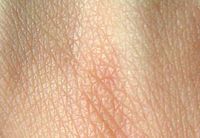
Photo from wikipedia
Abstract Background: Rat skin and goat cul de sac are mostly used in optimization of formulations as the model of human skin and cul de sac. Aim: To explore the… Click to show full abstract
Abstract Background: Rat skin and goat cul de sac are mostly used in optimization of formulations as the model of human skin and cul de sac. Aim: To explore the correlation between lipid content of rat skin and goat cul de sac and permeability. Materials and methods: Find out wavelength maximum for Sapat plus malam®, Ciplox eye ointment® and chloramphenicol eye caps and the standard curve was also derived. In vitro studies using Cellophane® membrane and ex vivo studies using rat skin or goat cul de sac of the formulations. Permeability coefficient, % dislodgeable dose, lag time, diffusion parameter, and partition coefficient were found for both studies after six and a half hours of penetration studies. Student’s unpaired t-test with equal variance was used to find any statistically significant difference in the ex vivo and in vitro diffusion transport studies at 95% level of confidence. Results: Permeability coefficient of Sapat plus malam®, Ciplox eye ointment® and chloramphenicol eye caps were 0.000316 ± 0.0000625, 0.00416 ± 0.0001, 0.0034 ± 0.00004 for Cellophane® membrane and 0.0001 ± 0.000001, 0.002254 ± 0.0002, 0.00303 ± 0.0001 for ex vivo membrane in cm2/min, respectively. For all three formulations, there were calculated t values which were higher than tabulated t values at 95% of confidence level (P<0.05). Conclusion: Cellophane® membrane shows a better diffusion than rat skin or goat cul de sac. In the optimization of formulation, only Cellophane® membrane is advisable to use.
Journal Title: Folia Medica
Year Published: 2017
Link to full text (if available)
Share on Social Media: Sign Up to like & get
recommendations!